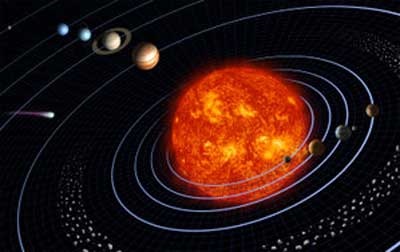The messenger of the distant universe has come to Earth?
The secret of the formation of the solar system will soon be clear? For the first time, dust samples from distant universes contained in comets have been collected on Earth by the US space agency (NАSА) .
A small box is located on the deck of the "Stardust" probe, grounded on the morning of January 15, 2006 at the Uta state military base (USA). On January 17, 2006, it was taken to the space center called Lindon Jhonson of Houston (Texas) to separate cosmic dust from other impurities.

The secret of the formation of the solar system will soon be clear? ( Photos: Wikipedia)
'The intention to study the material composition of comets with the purpose of understanding the structure of the Solar System has long been a concern for NASA. On July 4, 2005, at a distance of about 134 million kilometers from Earth, a 400-kilogram probe was cut across the comet 'Tempel-1'.
According to the vice president of the Russian Academy of Sciences, academician Vladimir Fortov - the recent " comet bombardment" has not affected our Earth.
The collected dust samples were formed 4.5 billion years ago, comparable to the time of formation of the solar system that will help scientists understand our 'solar system civilization' .
"In this box - is our treasure," said 'Stardact' project leader Don Braunli. The 'New York Times' newspaper cited experts' claims that the collected dust particles had a thickness not greater than the hair, but in it contained the key to opening up the formation of the solar system, and moreover, it provides the basic factors that lead to life on Earth, which are related to the time when new life arises in the solar system, these evidence so far. I've never seen it - according to Dr. Simon Grin of the US Open University.
The 'Stardust' universe has been in operation for seven years, during which time it made a five-billion-kilometer journey in the universe, in particular it carried a 45-kilogram container of cosmic dust collection. .
The 'Stardust' device was launched in 1999, January 2, 2004, it flew through Wild 2 comet tail and collected dust samples from comets.
Scientists believe that the Wild-2 stars fly from the Koupera rim of Neptune's planetary band. In addition to collecting dust, it also took pictures and collected other scientific data.
Duy Khanh (General box of sources from Russian РИА News)
- Capture the most distant object in the universe
- Find the farthest galaxy
- Messenger ship is about to fly Mercury
- Interstellar objects spread life from Earth into the universe
- Discover the oldest galaxy in the universe
- Discover the place that contains the most water in the universe
- Discover the most distant galaxy group
- Explore Mercury from Messenger spacecraft
- Spectacular scenery on earth
- Mercury is not a dead planet
- The most distant supernova ever discovered
- Revealing the eradication moment of the Earth and the universe
 Van Allen's belt and evidence that the Apollo 11 mission to the Moon was myth
Van Allen's belt and evidence that the Apollo 11 mission to the Moon was myth The levels of civilization in the universe (Kardashev scale)
The levels of civilization in the universe (Kardashev scale) Today Mars, the sun and the Earth are aligned
Today Mars, the sun and the Earth are aligned The Amazon owner announced a secret plan to build a space base for thousands of people
The Amazon owner announced a secret plan to build a space base for thousands of people